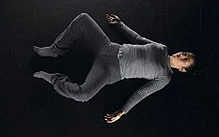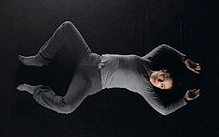As humans get older, we retain a strong ability to keep learning new things. Indeed, we now know that the human brain can reengineer many of its features.
As I emphasized throughout the book Change Your Age, the best way to break through restrictive boundaries is to explore and discover new ways to move. Babies have to do it every day, all day. All humans learn to walk, to sing, to dance, by first learning new ways to move. Think of any skill you ever acquired in your entire lifetime, and you can appreciate the fact that you acquired that skill by altering and redesigning your habits.
Here are a couple Change Your Age tips on how to transform your movement habits and a sample lesson from the book Change Your Age.
How to Transform Your Habits
 Tip #1: Moving from sitting to standing is only part of a full range of movement that allows you to go from squatting to standing and jumping. Sit in the middle of your chair and jump your pelvis forward and back on your chair without using your hands. Then, before you stand up, think that you’re going to jump. Don’t actually jump—just feel the act of standing from a chair on the way to jumping. It should be a feeling of lightening the load.
Tip #1: Moving from sitting to standing is only part of a full range of movement that allows you to go from squatting to standing and jumping. Sit in the middle of your chair and jump your pelvis forward and back on your chair without using your hands. Then, before you stand up, think that you’re going to jump. Don’t actually jump—just feel the act of standing from a chair on the way to jumping. It should be a feeling of lightening the load.
Tip #2: Go for a practice walk, either in your house or outdoors. Practice aiming your knees in the direction you’re going. For instance, aim your knees toward a door on the other side of the room. If you see a tree down the street, aim your knees at the tree. As you begin your walking motion by first bending your knee, you’ll find that your hips move more and your feet lift more. It should feel a little bit like marching.
Movement Habits- Sample Lesson
This lesson asks you to be intuitive and instinctual and to trust yourself. Unlike other fitness books, you won’t find strict rules on repetitions or time limits here; I’ll suggest parameters, but the Change Your Age program is about being in touch with your body and brain—and your sense of movement.
Before you start this lesson, read through it and look to the photos for guidance. This mental rehearsal will help you unleash your physical imagination.
- GO SLOWLY—Take your time, you’ll learn more!
- INSIST ON COMFORT—If it hurts, it’s not helping you. Never try to override pain if you feel it.
- USE YOUR IMAGINATION—Allow the movement to become very clear and lucid in your mind, like a scene from a movie.
- REST FREQUENTLY—These movements, while gentle and pleasurable, may cause slight strain because you are using parts of muscles you may not have used in a long time, or you may be using them in ways that are not familiar.
- CHOOSE A COMFORTABLE SPACE—Make sure that you have space around you to move and that your clothes are loose enough to not restrain your movement.
Lesson 2: Releasing the Hips into Pleasure

Intention: To find a comfortable and pleasurable way of releasing excess work in the stiff muscles of your inner legs and hips.
Starting Position: Lie on your back with your arms down at your sides and your legs long.
1. Feel the pressure under your heels and notice whether you feel more pressure from the floor touching your left heel compared to your right. Is the pressure on the outside of the heel more apparent on one side than the other? Also observe the pressure under your calf muscles. Does that pressure help tell you which of your two legs is pointed more to the ceiling and which is pointed more to the outside? Make sure your legs are relaxed. Don’t try to hold them in any particular way.
2. Very gently turn your right leg farther to the right and let your knee softly bend so that the outside edge of your right foot begins to slide on the floor up toward you. Then, slide the edge of your foot back down the same track it went up. Repeat the movement several times, very slowly, searching for the path of least resistance and effort as you slide the outside edge of your foot up and down on the floor.
Change Your Age Tip: As you slide your foot up and down, make sure your knee hangs open completely so that there’s no work happening in the inner muscles of your thigh. The more unnecessary muscular work you perform, the more difficult, heavy, and resistant the movement of the leg becomes. Every so often let your leg rest, with your knee bent and your foot pulled up, to make sure you are letting go of your inner thigh muscles.
After exploring the movement of sliding the edge of your right foot up and down the floor, rest and observe what has changed in the way your leg rests on the floor. Is your leg softer? Is it pointing in a different direction than earlier? Does your hip feel softer? You might even find that your lower back has released to the floor on the right side.

3. Perform the same exploration of this soft and lazy movement on the left side. Is it easier or harder than on the right? Notice whether your eyes or even your head want to move to the left when you move your left leg up and down. Rest. Feel the expansion in your pelvis and the release of excess work in your legs. Pause with your legs long and arms down at your sides.
4. Turn both of your legs open, with the knees hanging apart, and slide the outside edges of both of your feet up toward yourself at the same time. As you go up and down this way, slowly and gently, feel what your back and your pelvis are doing to assist the movement.
As the edges of your feet slide up, keep some distance between them.
 5. Rest with your arms on the floor above your head and your elbows slightly bent out to the sides. Once again, slide the outside edges of both feet up toward yourself and leave them there with your knees hanging open. Now let your head easily roll from side to side while breathing deeply.
5. Rest with your arms on the floor above your head and your elbows slightly bent out to the sides. Once again, slide the outside edges of both feet up toward yourself and leave them there with your knees hanging open. Now let your head easily roll from side to side while breathing deeply.
Rest in this position, with the knees suspended and the arms open, and feel the comfort of being like a baby sleeping on the floor. Let your ribs move freely as you breathe. If letting your knees hang open feels uncomfortable, place a pillow under the side of each knee to give yourself more support.
For more movement lessons, tips and helpful routines, buy the Change Your Age book and the Change Your Age video program.
